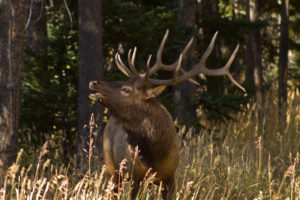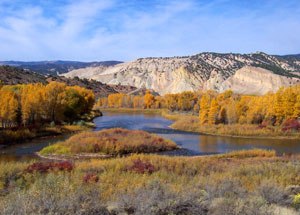By Randy Scholfield
South Park is something special. This vast open landscape in western Colorado once was prized hunting lands for the Ute Indians. Today, the area remains a favorite outdoors playground for Colorado hunters, anglers and recreationists as well as a critical source of water for the Denver metro area.
Trout Unlimited and partners are working to keep it that way.
TU, the National Wildlife Federation and Park County officials met last week with Sen. Michael Bennet, who was in South Park to learn more about the BLM’s Master Leasing Plan for the area—part of the agency’s new Planning 2.0 approach, which emphasizes gathering input from local stakeholders early on to avoid, as much as possible, oil and gas leasing controversies.
Over lunch in Fairplay, Bennet heard from the group how much South Park means to its residents, and to the Front Range.
County Commissioner Mark Dowaliby, who like many residents visited the area years ago and never left, noted that Park County is 60 percent public lands. And while the county is staunchly conservative, he said, residents feel strongly about conservation and protecting the area’s natural resources.
The Master Leasing Plan provides an opportunity for locals to give the BLM feedback on what kind of management and protections they’d like to see. In simple terms, an MLP is a zoning plan to help ensure that we conserve our outdoor heritage, protect water supplies, and see that oil and gas development takes place responsibly and in the right places. That includes deciding where drilling shouldn’t occur.
“South Park is a tremendous migratory area,” said Bill Dvorak, a local rafting outfitter, TU member and National Wildlife Federation organizer. The area is home to large herds of deer, elk, pronghorn and moose. “That’s why NWF got involved. We identified this area as a place that needed different rules” for oil and gas leasing.
“This is the backyard of the Front Range,” TU’s Tyler Baskfield told Sen. Bennet. “We have 54 miles of Gold Medal waters, including the Dream Stream and Spinney Mountain Reservoir—and it’s within an hour and a half of anywhere on the Front Range.” The area, he pointed out, is a “huge driver for hunting and fishing in the state.”

Meeting in South Park: Bill Dvorak, Sen. Michael Bennet, TU's Tyler Baskfield
Indeed, South Park generates some $17 million a year in wildlife-related revenue, according to Colorado Parks and Wildlife. Moreover, Denver, Aurora and other Front Range communities depend on South Park reservoirs for more than one-third of their drinking water. That’s why Denver Water and other providers have supported the MLP process.
Sportsmen’s groups like TU and NWF aren’t opposed to responsible energy development. That said, they want drilling done right and carefully sited, because some natural areas are simply too valuable to develop.
South Park has proven underground oil and gas reserves, but the fields are fragmented and disjointed, making extraction more difficult. Still, the reserves are there, and they could be targeted in the future—all the more reason to put in place “smart from the start” rules that clarify what areas can be developed and how.
After the meeting, Sen. Bennet accepted the group’s invitation to do a little fishing on the Elevenmile stretch of the South Platte. While the fishing wasn’t on fire that afternoon, Sen. Bennet managed to land the one fish brought to net by the group—a nice brown trout. The senator called the Elevenmile canyon stretch “spectacular.”

Sen. Bennet fishing in Elevenmile Canyon stretch of South Platte: 'Spectacular' place
Asked what he is hearing from constituents while travelling the state, Sen. Bennet didn’t skip a beat, saying that Coloradans are tired of Washington, D.C.’s dysfunction: “They want us to work together to get something done.”
Maybe D.C. could learn something about the spirit of cooperation here in South Park. While it’s still getting started, the MLP already has prompted diverse local stakeholders, from ranchers to conservationists, to work together on key ideas for protecting public lands, including setbacks from Gold Medal streams and protection of critical game migration corridors, proving that collaboration is the key to solving public land management challenges.
Agency officials are expected to deliver the draft MLP for South Park this fall, which will then be open to further public input. We hope the BLM will stay on track to ensure this important process moves forward in a timely manner.
Thanks to Sen. Bennet for spending time in South Park and for championing the MLP’s collaborative, “smart from the start” approach. He clearly understands the value of South Park and the importance of balancing energy development with protection of our best wild places.
Randy Scholfield is TU’s director of communications for the Southwest region.







 Over the last decade population studies on the Animas have shown a decline. Although this year there wasn't a turn around, CPW Biologist Jim White told the Durango Herald, "It's been a really nice fish year. It’s definitely been more abundant than years past.”
Over the last decade population studies on the Animas have shown a decline. Although this year there wasn't a turn around, CPW Biologist Jim White told the Durango Herald, "It's been a really nice fish year. It’s definitely been more abundant than years past.” While the Animas is improving, the future of Cutthroat Trout in Hermosa Creek also have a bright future as stream improvements have been made to prepare for Colorado River Cutthroat reintroduction.
While the Animas is improving, the future of Cutthroat Trout in Hermosa Creek also have a bright future as stream improvements have been made to prepare for Colorado River Cutthroat reintroduction.

 “It’s just transfer. It’s not like we’re selling them.”
“It’s just transfer. It’s not like we’re selling them.” Public lands are for anglers, hunters, hikers, campers, backpackers, energy producers, mountain climbers, berry pickers, ranchers, horse packers, birders, timber operators, miners, snowmobilers, ATVer’s, mountain bikers.
Public lands are for anglers, hunters, hikers, campers, backpackers, energy producers, mountain climbers, berry pickers, ranchers, horse packers, birders, timber operators, miners, snowmobilers, ATVer’s, mountain bikers. Public lands are part of what define us as Americans. They are what remain of the great westward migration of the nation. They are the crucible upon which the character of the nation was formed. Our forebears left these lands to us, not so we could sell them to the highest bidder. They left them to us as an heirloom to pass on intact to the next generation. These lands are our birthright. They are a beacon of blinding and unwavering light on what it means to be free.
Public lands are part of what define us as Americans. They are what remain of the great westward migration of the nation. They are the crucible upon which the character of the nation was formed. Our forebears left these lands to us, not so we could sell them to the highest bidder. They left them to us as an heirloom to pass on intact to the next generation. These lands are our birthright. They are a beacon of blinding and unwavering light on what it means to be free.
 Because of this, fishing where feeder streams and tributaries confluence with larger streams is a good place to look as trout will be moving into these areas to spawn. "While we never advocate fly fishing for actively spawning fish that are on shallow gravel redds, these tributaries allow anglers to predict where to find larger fish,"
Because of this, fishing where feeder streams and tributaries confluence with larger streams is a good place to look as trout will be moving into these areas to spawn. "While we never advocate fly fishing for actively spawning fish that are on shallow gravel redds, these tributaries allow anglers to predict where to find larger fish,"  With blue wing olives as the primary food source, blue wing fly patterns are a primary "go-to" for fall anglers. But according to Vail Valley Anglers, size is more important than pattern, "Flies mimicking these bugs (BWO) should range from #18-24. This is more important than the actual fly pattern. Choose flies in olive or grey such as the trusty Parachute Adams, Sparkle RS-2, CDC Loop Wing Emerger or JuJu Baetis."
With blue wing olives as the primary food source, blue wing fly patterns are a primary "go-to" for fall anglers. But according to Vail Valley Anglers, size is more important than pattern, "Flies mimicking these bugs (BWO) should range from #18-24. This is more important than the actual fly pattern. Choose flies in olive or grey such as the trusty Parachute Adams, Sparkle RS-2, CDC Loop Wing Emerger or JuJu Baetis." More than a century ago, John Muir extolled the virtues of wild nature as a place of renewal for city folk: “Thousands of tired, nerve-shaken, over-civilized people are beginning to find out that going to the mountains is going home; that wildness is a necessity; and that mountain parks and reservations are useful not only as fountains of timber and irrigating rivers, but as fountains of life.”
More than a century ago, John Muir extolled the virtues of wild nature as a place of renewal for city folk: “Thousands of tired, nerve-shaken, over-civilized people are beginning to find out that going to the mountains is going home; that wildness is a necessity; and that mountain parks and reservations are useful not only as fountains of timber and irrigating rivers, but as fountains of life.”

